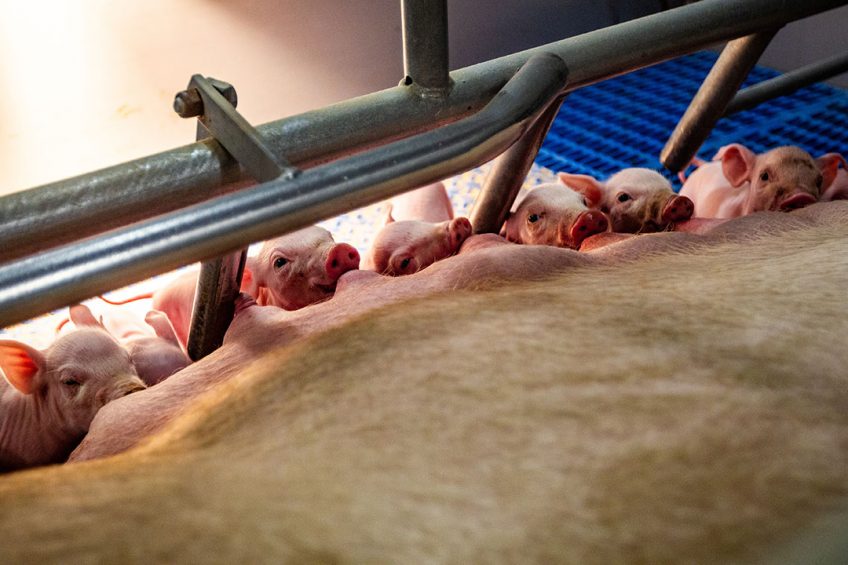Sows in top condition during lactation

Sow performance has increased in recent years. Improvements in genetics, nutrition and health status have driven these changes. Some nutritional solutions to deal with the increased demands for sows are still underutilised, carbohydrases being one of them.
Pig producers need sows to rear healthy and fast-growing piglets. A sow’s biggest challenge is to do that without losing too much body protein reserves, so that she returns to service quickly. Therefore, feed intake and nutrient use need to be optimised.
The digestibility of sow diets is affected by their capacity to digest non-starch polysaccharides (NSPs). As anti-nutrients, they reduce digestibility of the diet by nutrient entrapment, changes in diet viscosity and fermentation in the high gut. Carbohydrase addition is virtually standard in broiler diets and common in growing pig diets. Nutritionists, however, do not always value its effect in adult animals like sows. However, their use is justified since sow feed is usually highly fibrous and feed intake often limited.
Performance aims of sows
During lactation, the sows’ energy requirements increase dramatically. However, feed intake is self-limited during the first few days post-farrowing. During those significant metabolic changes, the mobilisation of body reserves is required. If this negative energy balance persists, then sows lose weight and milk production is affected. This is detrimental to both the sow and her piglets.
Quantity and quality of sow milk play a key role for the health and growth of her piglets. From an economic point of view, the number and weight of a litter at weaning, is an indicator of the future performance of sows. If sows are not in good body condition when their piglets are weaned, they will take longer to return to service. If the cycle repeats, long term reproductive performance is reduced along with her longevity in the herd. Adding a carbohydrase complex in lactating sow diets has been shown to increase the digestibility of protein and energy during lactation. With feed intake an issue for lactating sows, enzymes are added on-top of the existing formulation to maximise nutrient release from the diet. Up until recently, however, there were relatively few scientific studies to this approach. Therefore, several scientific studies were conducted, to evaluate the effect of a specific carbohydrase complex* on body condition, nutrient digestibility and piglet performance in lactating sows, under different conditions. These studies were included in a meta-analysis, consisting the eight trials. The results are presented below.
Parity principles
Parity has a large effect on a sow body condition at both the start and end of lactation. Being younger, primiparous sows have less body reserves to draw on. Sows in their first and second parities also are often not eating enough feed to meet their requirements for energy and amino acids. In the meta-
analysis, sows were put into three groups based on parity. Group 1 contained primiparous sows; group 2 was made up of second and third-parity sows; sows at parity four or higher were put into group 3.

What is the best way to manage sow herds? Find out more in our special ‘Sow Management’
Sow condition and body reserves
The sows studied lost 21kg in average of body weight during lactation. That loss was significantly different between parity groups – lower in group 1 and 3 than in group 2. The addition of the carbohydrase complex reduced body weight loss in all parity groups (Figure 1). The average reduction in weight loss of 3kg per sow, represents 1-2% of their body weight. Primiparous sows fed carbohydrases mobilised a significantly smaller percentage of their body stores. Those effects can be explained by better feed digestibility.
Figure 1 – Carbohydrase complex reduced sow body weight loss in all parity groups.
In both high- and low-density diets, specific carbohydrases complex addition increased dry matter, organic matter and energy digestibility. That means that the sows were able to access a larger amount of nutrients from the diet. Those effects were irrespective of dry matter intake, which was statistically the same between the four treatments. However, feed and energy intake did increase with parity. Primiparous sows fed the control diets had a lower energy intake and lost more weight than multiparous sows. A clear relationship was found between net energy intake, body weight variation and litter weight gain.
Nutrient partitioning
From the results of sows fed carbohydrases a higher net energy (NE) intake was estimated and compared with bodyweight loss. Energy was partitioned differently, between growth and milk production, depending on parity and sow condition. The study showed that additional NE intake of primiparous sows was preferentially used to improve their body condition, rather than for milk production. That strategy, associated with incomplete development of primiparous sows, will help to reduce body weight loss – protecting her long-term performance. In older sows, with higher levels of back fat, it is more important to optimise milk production and raise healthy litters.
Litter weight gain is affected by feed intake, particularly in primiparous sows – due to their higher requirements for growth and lower body reserves. The use of this carbohydrase complex increased litter weight gain up to weaning (see Figure 2). That effect was bigger in litters from multiparous sows – possibly due to variations in body weight and litter weight gain – or because of differences in nutrient partitioning. Weight at weaning is a predictor of future pig performance. A good start being key to efficient growth, health and optimal days to slaughter.
Figure 2 – Carbohydrase complex increased piglet liveweight gain in all parity groups.
Conclusion
In order for a sow to rear a litter and return to service in a good body condition after the piglets are weaned, she needs to ingest a sufficient amount of nutrients to produce milk, without losing too much weight. Despite an increase in feed intake at the onset of lactation, sows can lose up to 10% of their body weight. Reducing the loss of body reserves has a significant effect on subsequent reproductive cycles. Therefore, strategies to improve the nutrient intake of sows will benefit both health and economic performance.
From this meta-analysis, it’s clear that this carbohydrase complex is a solution to alleviate the effects caused by high sow productivity. Supplementation reduced sow body weight loss and increased diet digestibility. By increasing daily energy intake, carbohydrases are aiding the development of sows. It also results in larger and heavier litters of piglets, which as a predictor of future pig performance, is economically important for pig producers.
* Rovabio Excel, Adisseo, France













